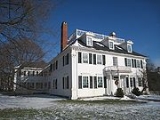
Governor John Langdon House
Encyclopedia
The Governor John Langdon House, also known as Governor John Langdon Mansion, in Portsmouth
, New Hampshire
, USA, is a mansion house built in 1784 by John Langdon
, that is now a National Historic Landmark
. Langdon was a merchant, shipbuilder, American Revolutionary War
general, signer of the United States Constitution
, and three-term President (now termed governor) of New Hampshire. The house he built for his family expresses his status as Portsmouth's leading citizen and received praise from George Washington
, who visited there in 1789. Its reception rooms are ornamented by elaborate wood carving in the rococo
style.
After Langdon's death in 1819, the house was occupied by other leading families. At the end of the 19th century, Langdon descendants purchased the house and restored it to its 18th-century glory, adding on a substantial wing designed by McKim, Mead, and White
to house modern conveniences
. The garden, dating from the same era, features restored perennial beds, a rose and grape arbor, and a pavilion. The house and grounds are now owned and operated as a house museum by Historic New England
.
The house was declared a National Historic Landmark
in 1974.
It is located at 143 Pleasant Street in Portsmouth
.
Portsmouth, New Hampshire
Portsmouth is a city in Rockingham County, New Hampshire in the United States. It is the largest city but only the fourth-largest community in the county, with a population of 21,233 at the 2010 census...
, New Hampshire
New Hampshire
New Hampshire is a state in the New England region of the northeastern United States of America. The state was named after the southern English county of Hampshire. It is bordered by Massachusetts to the south, Vermont to the west, Maine and the Atlantic Ocean to the east, and the Canadian...
, USA, is a mansion house built in 1784 by John Langdon
John Langdon
John Langdon was a politician from Portsmouth, New Hampshire, and one of the first two United States senators from that state. Langdon was an early supporter of the Revolutionary War and later served in the Continental Congress...
, that is now a National Historic Landmark
National Historic Landmark
A National Historic Landmark is a building, site, structure, object, or district, that is officially recognized by the United States government for its historical significance...
. Langdon was a merchant, shipbuilder, American Revolutionary War
American Revolutionary War
The American Revolutionary War , the American War of Independence, or simply the Revolutionary War, began as a war between the Kingdom of Great Britain and thirteen British colonies in North America, and ended in a global war between several European great powers.The war was the result of the...
general, signer of the United States Constitution
United States Constitution
The Constitution of the United States is the supreme law of the United States of America. It is the framework for the organization of the United States government and for the relationship of the federal government with the states, citizens, and all people within the United States.The first three...
, and three-term President (now termed governor) of New Hampshire. The house he built for his family expresses his status as Portsmouth's leading citizen and received praise from George Washington
George Washington
George Washington was the dominant military and political leader of the new United States of America from 1775 to 1799. He led the American victory over Great Britain in the American Revolutionary War as commander-in-chief of the Continental Army from 1775 to 1783, and presided over the writing of...
, who visited there in 1789. Its reception rooms are ornamented by elaborate wood carving in the rococo
Rococo
Rococo , also referred to as "Late Baroque", is an 18th-century style which developed as Baroque artists gave up their symmetry and became increasingly ornate, florid, and playful...
style.
After Langdon's death in 1819, the house was occupied by other leading families. At the end of the 19th century, Langdon descendants purchased the house and restored it to its 18th-century glory, adding on a substantial wing designed by McKim, Mead, and White
McKim, Mead, and White
McKim, Mead & White was a prominent American architectural firm at the turn of the twentieth century and in the history of American architecture. The firm's founding partners were Charles Follen McKim , William Rutherford Mead and Stanford White...
to house modern conveniences
Modern conveniences
Modern conveniences or Mod cons are labor-saving devices that make a task easier to perform than a traditional method. Because of the historical use of the term, and the differences in lifestyles around the world, the term is a relative term based upon the conveniences previously available to a...
. The garden, dating from the same era, features restored perennial beds, a rose and grape arbor, and a pavilion. The house and grounds are now owned and operated as a house museum by Historic New England
Historic New England
Historic New England, previously known as the Society for the Preservation of New England Antiquities , is a charitable, non-profit, historic preservation organization headquartered in Boston, Massachusetts. It is focused on New England and is the oldest and largest regional preservation...
.
The house was declared a National Historic Landmark
National Historic Landmark
A National Historic Landmark is a building, site, structure, object, or district, that is officially recognized by the United States government for its historical significance...
in 1974.
It is located at 143 Pleasant Street in Portsmouth
Portsmouth, New Hampshire
Portsmouth is a city in Rockingham County, New Hampshire in the United States. It is the largest city but only the fourth-largest community in the county, with a population of 21,233 at the 2010 census...
.

